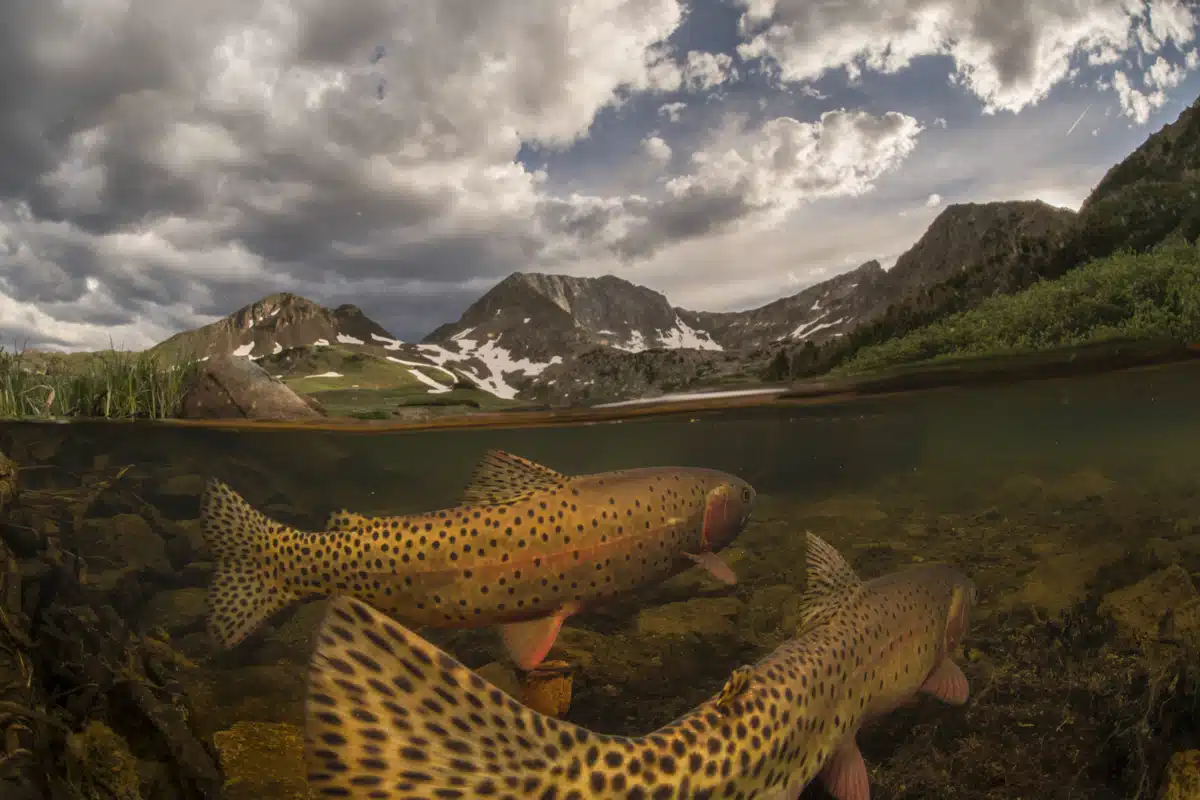
Hidden beneath the iconic peaks of Colorado’s high country a pair of Colorado River Cutthroat trout spawn in the gravels of a small lake outlet. (Photo: © David Herasimtschuk / Freshwaters Illustrated)
Conservation photographer David Herasimtschuk grew up on the bank of Colorado’s Cache la Poudre River. Those early experiences catching toads and splashing in the water transformed into a lifelong passion for nature. This passion initially pushed him to study wildlife and fishery biology and then moved him toward visual storytelling.
Today, as the lead photographer for Freshwaters Illustrated, he tells the stories of North America’s rivers and the challenges that the animals who inhabit these spaces face. At the same time, he also continues his conservation photography on land. Herasimtschuk’s explorations of the Pacific Northwest’s old-growth forests provide much-needed visuals that remind us that our homegrown landscape also plays a critical role in our planet’s health.
We had a chance to speak with Herasimtschuk about his early love for the environment, his inspirations, and the most dramatic environmental changes he has witnessed during his career. With his expertise in biology and photography, the conversation is a fascinating marriage of striking visuals and scientific know-how. Read on for My Modern Met’s exclusive interview.
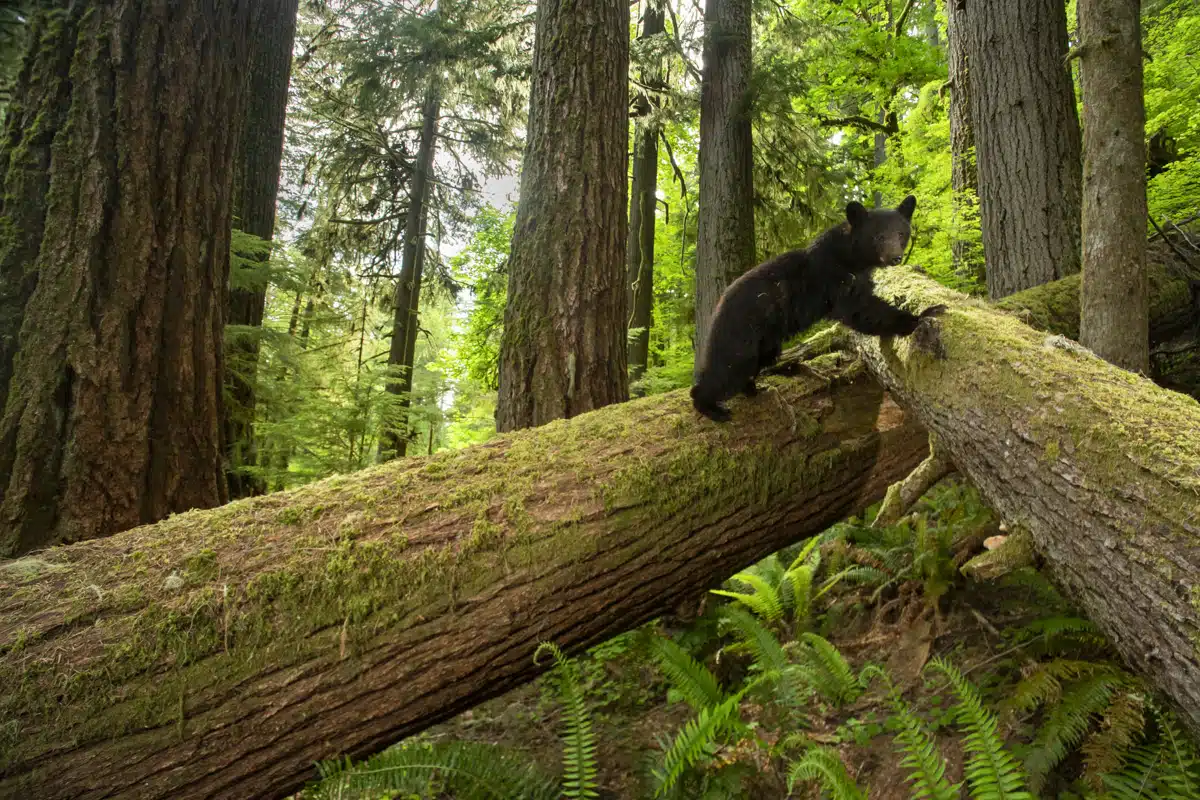
Navigating a maze of giant Douglas firs, a large black bear explores its home in one of the last old-growth stands left in Oregon’s Coast Range. These towering trees provide important habitat for bears, who use tree cavities as denning sites for their young and for hibernation. (Photo: © David Herasimtschuk)
How did your love for environmental and wildlife photography develop?
Exploring the natural world has been a passion of mine for as long as I can remember. I was fortunate to grow up along the banks of Colorado’s Cache la Poudre River and spent much of my childhood immersed in its waters. Fascinated by all the creatures it supported, the river became a living classroom, teaching me how to observe life, both above and below the surface, and instilling a deep connection to freshwater that I carry with me today.
My journey to photography and filmmaking took root in college, where I studied wildlife and fishery biology at Colorado State University. Summers were spent as an aquatic technician for the U.S. Forest Service, surveying vulnerable species in high-altitude freshwater habitats. I started bringing my camera into the field to capture these rare animals and quickly realized how visual storytelling could amplify efforts to protect these declining species and the ecosystems they depend on.
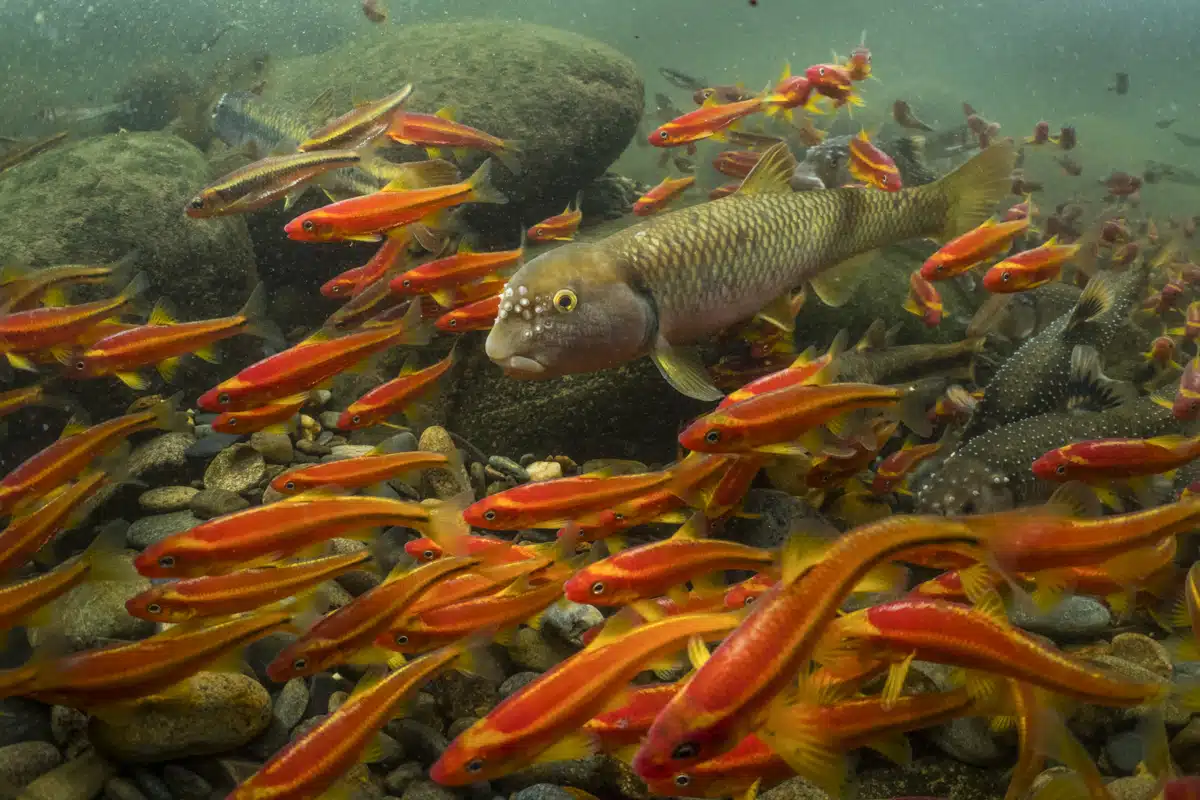
A pulsating blaze of breeding saffron and Tennessee shiners engulf a male river chub as he tirelessly works to build his rock nest. One of the most unique fish found in the Southern Appalachian Mountains, the craftsman-like river chub will pick up stones and carry them in his mouth, building a large gravel nest where female chubs will come to lay their eggs. These immaculate nests also attract other species of minnows looking for clean gravel to lay their eggs in. Many species, like saffron and Tennessee shiners, rely heavily on the chub’s nest building skills, taking advantage of these gravel nurseries for their young. The Southeastern US is not a place people often think of as having great diversity yet, some of the most biologically diverse rivers in the world can be found in Southern Appalachia. (Photo: © David Herasimtschuk / Freshwaters Illustrated)
(continued) As I dove deeper into my studies of freshwater ecosystems in college, my connection to these environments grew stronger. I was struck by the incredible diversity they harbor, including nearly half of the world’s fish species. Sadly, I also came to realize that this extraordinary diversity often goes unnoticed and underappreciated by the public, with very little representation in mainstream media. Currently, freshwater biodiversity is being lost at rates two to three times faster than that of marine and terrestrial environments, yet these ecosystems and the life within them continue to receive very little attention.
As I shifted from science to storytelling, my career has adapted, embracing photography and filmmaking as essential tools for communicating the importance of the natural world. Combining my background in ecology and conservation with a passion for capturing life below the surface, I have worked to foster new perspectives on how we see aquatic ecosystems. Over the last 20 years, I’ve dedicated my life to documenting the great diversity of life found in freshwater, and have worked with Freshwaters Illustrated to create a number of films and photo stories that share the value, importance, and beauty of these environments.
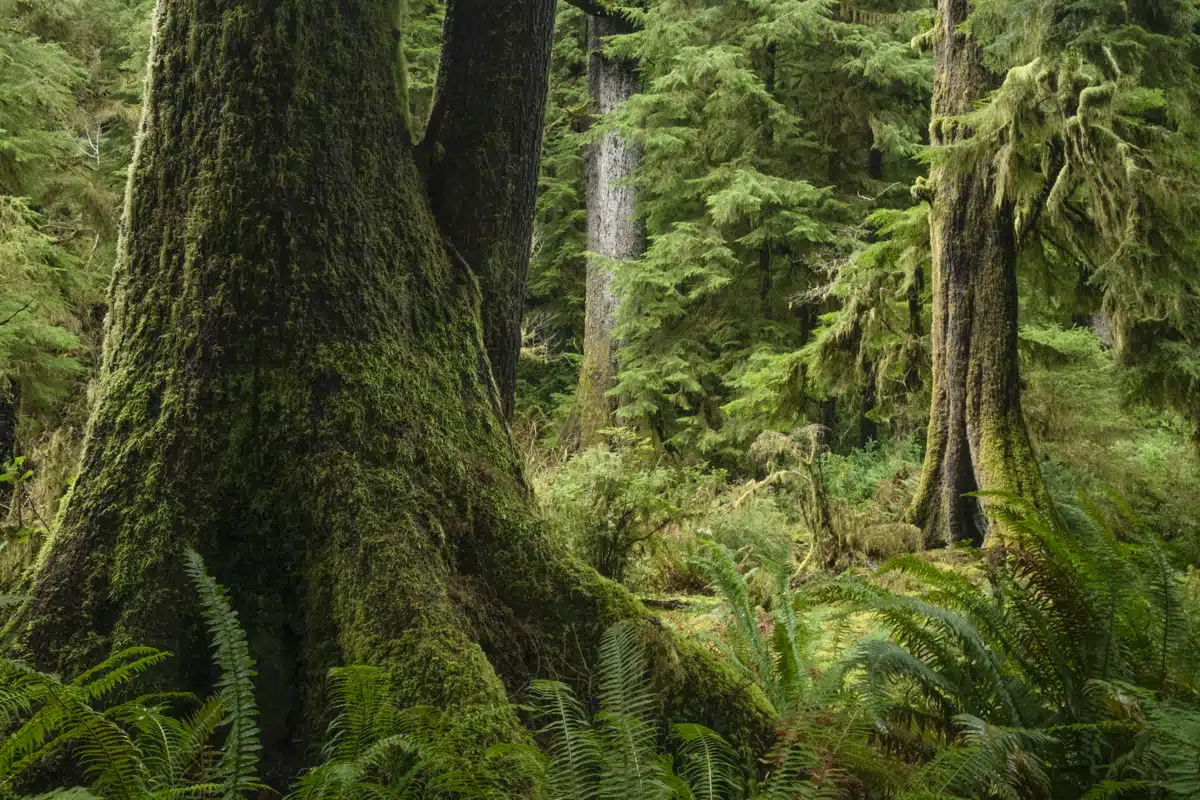
A group of ancient Western Hemlocks and Sitka Spruce in an old-growth forest in Oregon’s Coast Range. Hemlock/Sitka Spruce stands sequester and store large amounts of carbon due to their fast growth rates and because of the wet climate they inhabit. (Photo: © David Herasimtschuk)
What inspires you about the forest of the Pacific Northwest?
There is a sense of awe and magic in old-growth forests that is difficult to articulate. These ancient landscapes resonate deep into the spirit, evoking feelings of curiosity and wonder that I have not experienced elsewhere. The sheer scale of the towering trees and the intricate layers of the forest spark a deep fascination as if I’m stepping into a world where the wisdom of the planet is protected in each moss-covered trunk.
Yet, over the last 50 years, the reality is that such experiences have become increasingly rare. With so many old-growth forests lost to logging and environmental stressors, many people today never have the chance to walk among these giants or witness the complex ecosystems they support. This loss of connection has created a shifting baseline and a new normal for what the public perceives as a healthy forest. As we witness the loss of these ancient landscapes, it becomes increasingly important to reconnect communities with the significance of these ecosystems, fostering a deeper understanding of their global significance and the urgent need for their protection.
Old-growth forests are not just sources of beauty and wonder—they are some of the most powerful natural solutions to combating climate change. The temperate rainforests of the Pacific Northwest, in particular, have some of the highest capacity to capture and store carbon of any forest in the world, largely thanks to the oldest trees. These giants act as vital carbon sinks while providing critical habitat for countless species that rely on the forest’s complex web of life. Protecting and restoring these forests is more than an environmental necessity; it’s an opportunity to harness their potential to mitigate climate change. Through imagery and storytelling, I hope to inspire others to see the magic of these forests as I have and understand their global importance and need for protections.
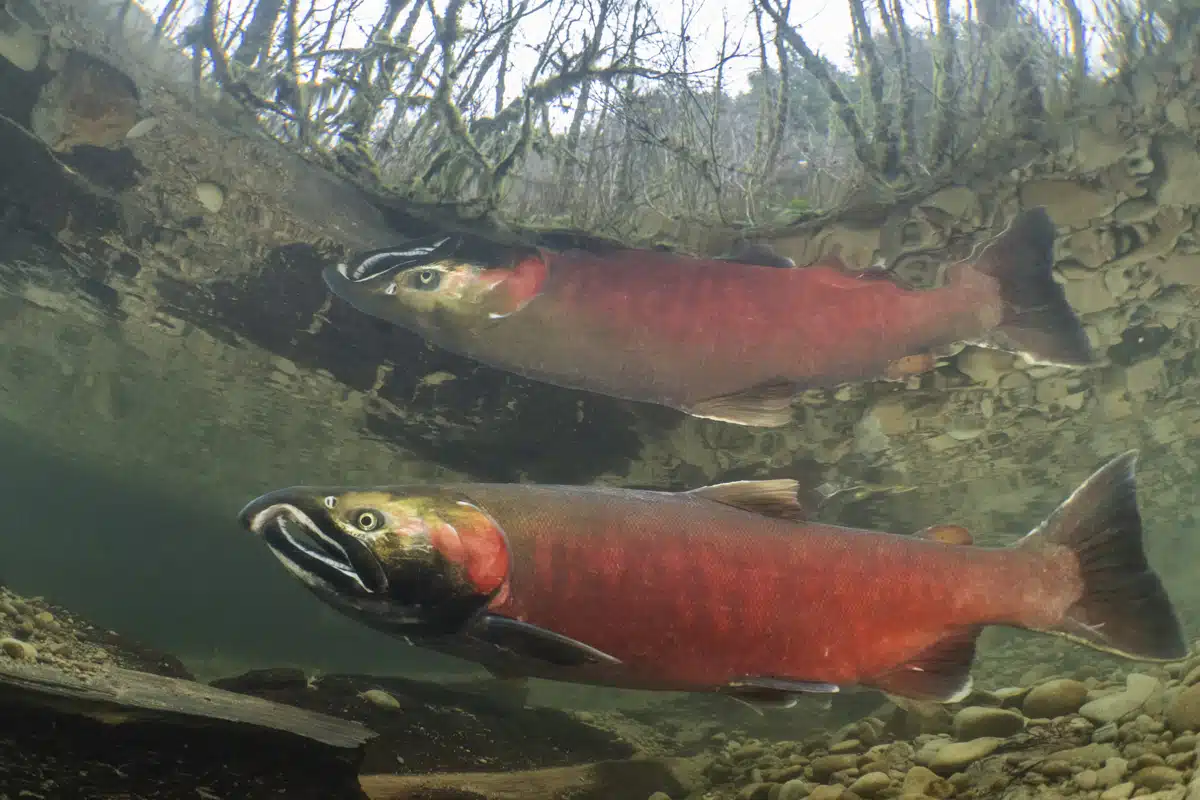
A male coho salmon migrates to its spawning waters in a small creek in Oregon’s Coast Range. Over a century of commercial logging has removed most of the old-growth trees from the region, resulting in riparian forests that are made up of much smaller trees. This lack larger trees has had a major impact on forest and river ecosystems in the Northwest, and remains as a major factor limiting in the conservation of federally protected fish, like coho salmon. (Photo: © David Herasimtschuk / Freshwaters Illustrated)
What is one of your most memorable wildlife encounters there?
For me, there are few experiences more memorable than spending time in the water with salmon. Each fall and winter, I make the annual pilgrimage to their rivers, immersing myself in the salmon’s life cycle and documenting the timeless connection between water, fish, and forest. Applying a great deal of patience and respect, there have been moments where I have peacefully snorkeled alongside massive walls of schooling salmon, feeling completely immersed in their world as they move in perfect unison, like a living, breathing function of the river.
Few events illustrate the connection of a species to its home, better than the sights, sounds, and smells of thousands of salmon migrating home. The chaotic excitement of spawning behaviors, along with the smell of decomposing fish, are all signs that new life is returning to the ecosystem.
Unfortunately, in the Pacific Northwest, it’s becoming increasingly difficult to experience salmon numbers that are even remotely similar to what was seen historically. With wild salmon numbers declining by nearly 90% in the region, the epic stories of “fish so abundant you could walk across the river on their backs” are beginning to feel more like myths and lore.
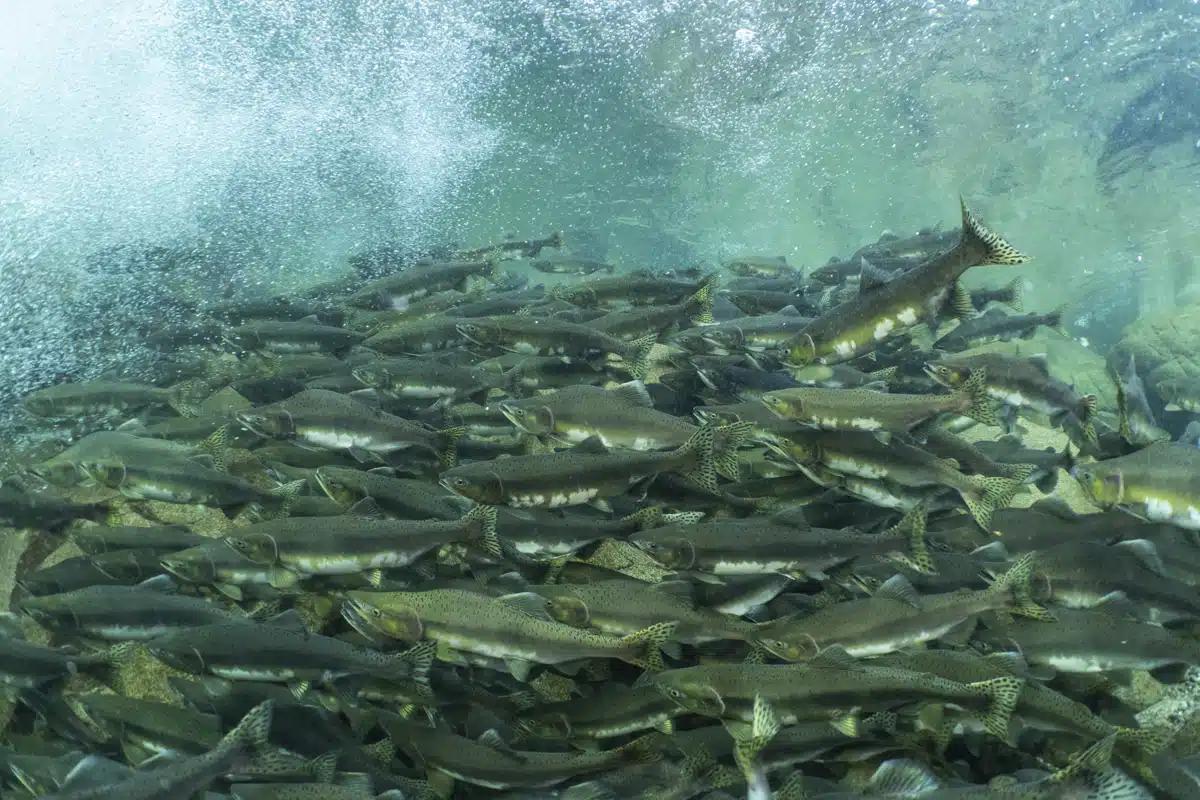
A large group of adult pink salmon stage in a pool as they wait for rains to raise water levels so they can continue migrating to their spawning grounds. In the Pacific Northwest sights like this are becoming increasingly rare as wild salmon numbers have declined by nearly 90 percent in the region. (Photo: © David Herasimtschuk / Freshwaters)
(continued) This shifting baseline of what we perceive as acceptable wild salmon numbers has repercussions that can be felt throughout Northwest ecosystems. This includes impacts on all the species that rely on the marine-derived nutrients that salmon bring back. Research has found that the historic biomass of salmon returning to the Pacific Northwest has dropped by over 90%. This dramatic decline not only threatens the survival of species such as bears, eagles, and orcas, which rely heavily on salmon for sustenance but also affects the health of forests, as decaying salmon carcasses once provided vital nutrients that helped sustain tree growth. As salmon populations dwindle, so too does the ecological balance that has supported these intricate systems for millennia, leaving a ripple effect that extends far beyond the rivers.
These dramatic reductions in nutrients are also believed to impact carbon sequestration. The forests of the Pacific Northwest having some of the highest carbon storage potential of any forest type in the world, and the ability for certain tree species to grow up to three times faster with salmon nutrients. It is believed that salmon restoration could be an important tool to help increase a forest’s ability to sequester carbon in the region.
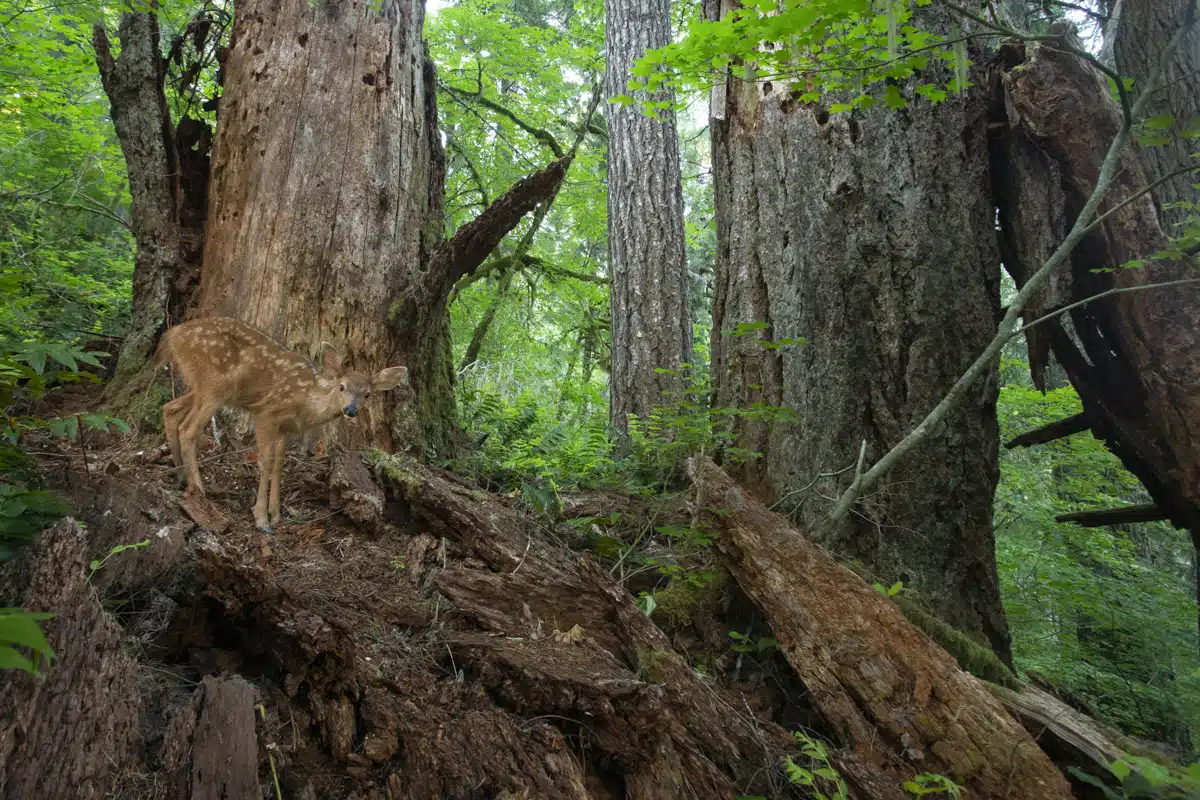
A young black-tailed deer blends in among a pair of decomposing Douglas Fir snags in Oregon’s Coast Range. Providing critical habitat for over one hundred species, snags help create nesting, shelter and foraging locations, and are an incredibly important component to healthy old-growth ecosystems. (Photo: © David Herasimtschuk)
What are the biggest environmental changes you’ve seen since you started documenting the area?
While there have been huge strides to increase protections for forest and freshwater ecosystems throughout the Pacific Northwest, the threat of commercial logging still continues to undermine these efforts, posing a significant risk to biodiversity, water quality, climate mitigation, and the overall health of these ecosystems.
Despite significant advancements in our ecological understanding of these environments and improved policy changes that have increased forest protection, commercial logging, especially on private land, remains a persistent threat to these ecosystems. Timber operations, whether through clear-cutting, poorly planned selective logging, or road construction, can lead to numerous problems that can impact communities at both local and global scales.
Furthermore, logging poses a direct threat to both water quality and quantity for ecosystems and local communities. The removal of trees diminishes the natural filtration system that forests provide and can affect water temperature, with potentially devastating consequences for sensitive species that rely on specific thermal conditions for survival. Recent research has also shown that industrial logging practices can impact water quantity. In Oregon’s Coast Range, stream flow decreased by 50% in forests that were cleatcut on 40 to 50 year rotations. This reduction in water can have a major impact on both forest ecosystems and municipal water supply.
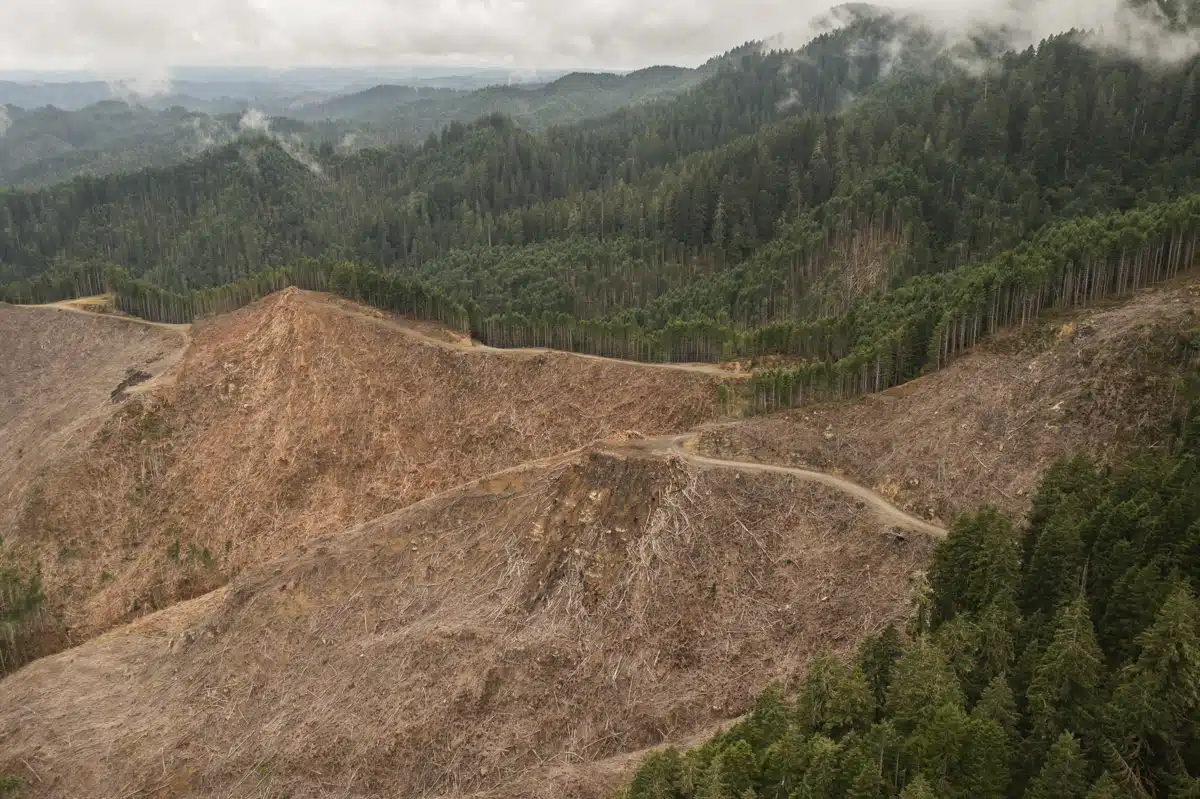
A clear cut forest in Oregon’s Coast Range. Research has found that industrial logging and wood products account for the largest source of carbon dioxide emissions in the state of Oregon. (Photo: © David Herasimtschuk)
(continued) Logging activities also significantly impact carbon sequestration and storage, which are critical processes for mitigating climate change. Forests act as carbon sinks, absorbing carbon dioxide from the atmosphere and storing it in their biomass and soil. When trees are cut down, not only is this carbon storage capacity reduced, but the act of logging itself releases stored carbon back into the atmosphere, exacerbating greenhouse gas emissions. The loss of forested areas limits the region’s ability to combat climate change and diminishes resilience against its impacts.
Compounding these challenges, climate change itself intensifies the threats facing forest and freshwater ecosystems. Rising temperatures and shifting precipitation patterns can lead to increased droughts, which stress both terrestrial and aquatic habitats, further reducing the already dwindling water quality and availability. Additionally, warmer waters can exacerbate the vulnerability of salmon populations, which require specific thermal conditions for spawning and growth. Climate change also increases the frequency and severity of wildfires, which can devastate large forest areas and release significant amounts of carbon into the atmosphere. Together, these factors create a precarious situation where the combined effects of logging and climate change threaten the delicate balance of ecosystems that are vital for the health of the Pacific Northwest.
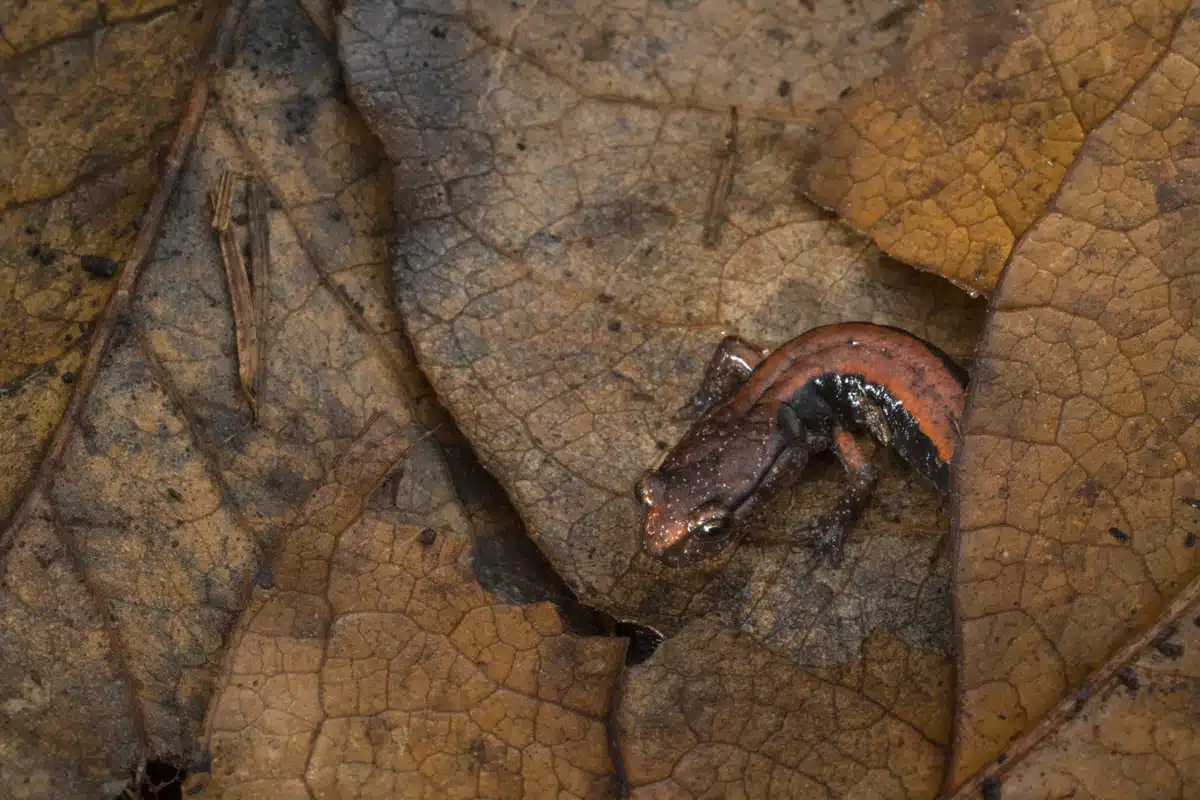
A Western red-backed salamander navigates the understory leaf litter in a mature forest in Oregon’s Coast Range. Researchers in the Northwest have found that woodland salamanders actually play an important role in carbon storage by feeding on invertebrates that release carbon. (Photo: © David Herasimtschuk / Freshwaters Illustrated)
What are your favorite hidden gems found in this environment?
In a realm of giants, the role of some of the smaller organisms can’t go unstated. Among the small yet mighty are one of my favorite groups of creatures, the salamanders. These amphibians, with their sleek forms and vibrant colors, are more than just fascinating inhabitants of the forest floor; they serve as vital indicators of ecological health, thriving in the moist, rich environments created by the forest’s intricate ecosystem.
Due to the cryptic nature of salamanders, their true importance within an ecosystem often remains hidden from view. These elusive amphibians, typically found nestled in damp leaf litter or tucked beneath rotting logs, might seem insignificant against the backdrop of towering trees. However, recent research has illuminated the vital role terrestrial salamanders play in the global carbon cycle, showcasing how their actions can have far-reaching effects.
In Northern California, scientists have discovered that salamanders contribute to carbon storage by preying on invertebrates that feed on decomposing organic matter. These creatures engage in behaviors such as shredding and tearing leaves, a process that releases carbon dioxide into the atmosphere. By controlling the populations of these leaf-feeding invertebrates, salamanders effectively help prevent excess carbon from being released, allowing more of it to remain locked in the organic matter on the forest floor. This not only contributes to the overall health of the forest ecosystem but also supports the critical process of carbon storage.
The interactions between salamanders, invertebrates, and the forest environment illustrate the intricate connections within ecosystems. These rarely encountered amphibians, despite their small size and elusive nature, play a critical role in maintaining the health of our planet. By understanding and appreciating the contributions of species like salamanders, we can better recognize the importance of preserving these unique creatures and their habitats, ensuring they continue to influence environmental dynamics on a global scale.
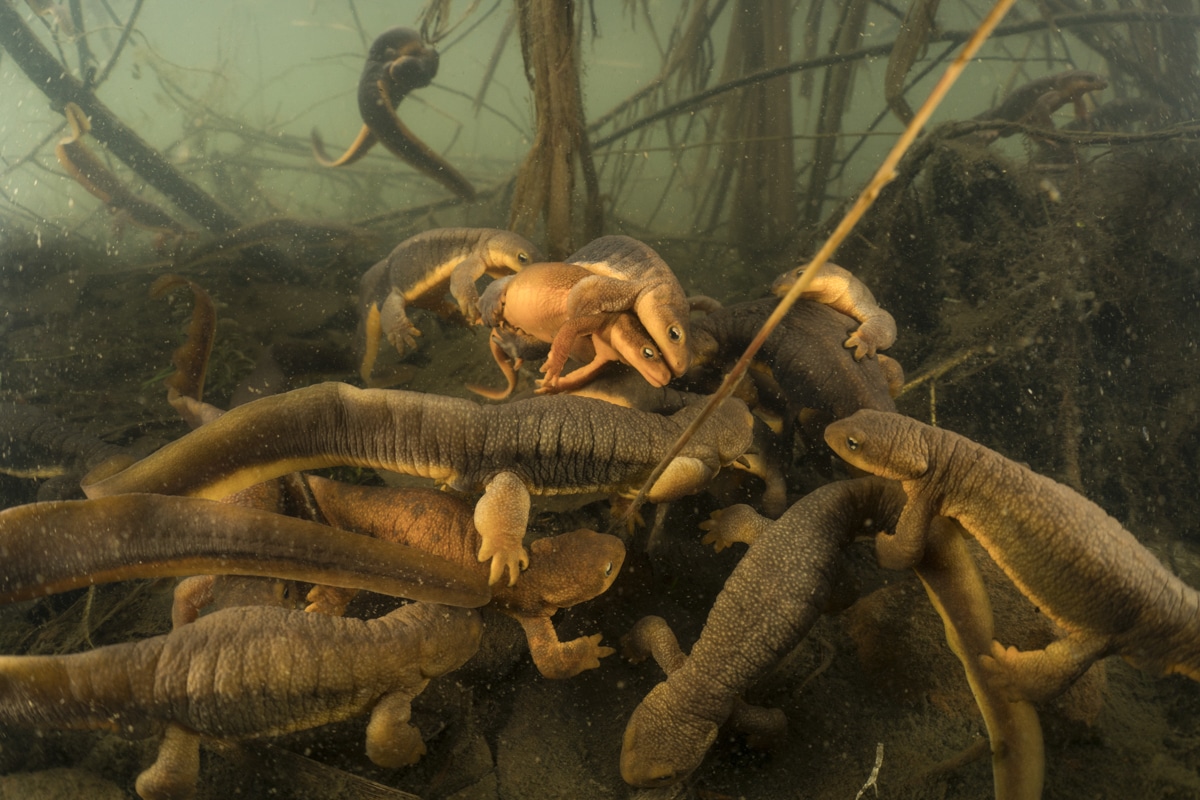
A group of rough-skinned newts interact with a breeding pair of newts in a small pond in Oregon’s Coast Range Mountains. (Photo: © David Herasimtschuk / Freshwaters Illustrated)
What do you hope that people take away from your work?
As climate change reshapes our planet, many seek to understand how the natural world connects to their everyday lives. So often the questions are asked: what is the value of biodiversity? Or what is the value of a forest? The forests of the Pacific Northwest provide a profound answer, serving as vital ecosystems that support a rich diversity of life, store and sequester large amounts of carbon, and regulate community water supplies.
Inspired by the work of forest scientists and advocates, and having been fortunate to spend a great deal of time in these ancient ecosystems, I feel a profound responsibility to communicate their importance. Through storytelling imagery that highlights the significance of forest life, I aim to engage and inform audiences about the vital role of old-growth ecosystems in the Pacific Northwest. By shining a light on the individual species and their interconnections within these ecosystems, I hope to inspire curiosity and wonder, motivating people to explore and learn more about the intricate relationships that sustain our planet.
As our demand and impact on forests continues to grow worldwide, I believe images and stories of the environments and species affected will play a critical role in visually connecting forest ecosystems to their would-be stewards. Understanding the importance of biodiversity and how forests function is a critical part in creating that connection. With many decisions currently being decided about the fate of our forests in the Pacific Northwest, and the world, it’s important that the public and decision-makers have the information they need to make science-based decisions in regard to forest management and protections.
